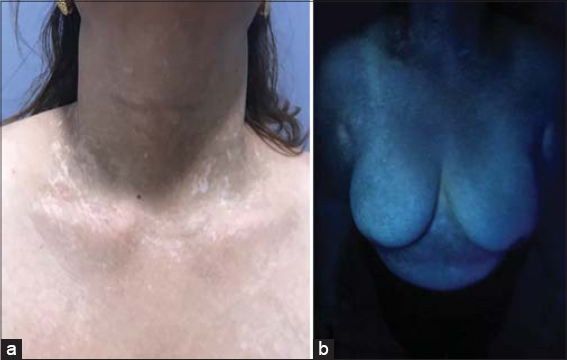Acquired hypopigmentation: Cases for diagnosis
Selma El Kadiri , Hanane Bay Bay, Rhizlane Chaoui, Zakia Douhi, Sara Elloudi, Fatima-Zahra Mernissi
, Hanane Bay Bay, Rhizlane Chaoui, Zakia Douhi, Sara Elloudi, Fatima-Zahra Mernissi
Department of Dermatology, CHU Hassan II, Fez, Morocco
Corresponding author: Dr. Selma El Kadiri
Submission: 29.02.2020; Acceptance: 05.04.2020
DOI: 10.7241/ourd.2020e.38
Cite this article: El Kadiri S, Bay Bay H, Chaoui R, Douhi Z, Elloudi Z, Mernissi F-Z. Acquired hypopigmentation: Cases for diagnosis. Our Dermatol Online. 2020;11(e):e38.1-e38.2
Citation tools:
Copyright information
© Our Dermatology Online 2020. No commercial re-use. See rights and permissions. Published by Our Dermatology Online.
ABSTRACT
Chemical leukoderma is an acquired depigmentation or hypopigmentation caused by repeated application of or exposure to a specific chemical that is toxic to epidermal melanocytes. Chemical leukoderma is often misdiagnosed as idiopathic vitiligo. We report 2 cases of leucomelanoderma induced by mequinol.
Key words: Voluntary depigmentation; Leucomelanoderma; Mequinol
INTRODUCTION
Voluntary depigmentation is a common practice in Africa [1]. These depigmenting products are available without a prescription. However, some agents provide side effects that are sometimes irreversible, hence their withdrawal from the market. We report 2 cases of leucomelanoderma induced by mequinol.
Case Reports
Case 1
A 37-year-old woman with no previous personal or familial history of vitiligo had for 3 years centrofacial melasma and applied a mequinol cream for 3 months. The evolution was marked by the attenuation of pigmentation. Subsequently, secondary vitiligo-like depigmented lesions appeared progressively on her face, neck, and abdomen. Clinical examination showed sharply marginated patches with confetti macules seen at the periphery concentrated mostly in areas of repeated contact with mequinol. The patient presented also hypopigmented macules on her abdomen with enhancement under Wood’s lamp (Figs. 1a and 1b). A punch biopsy showed an absence of melanocytes identical to lesions of true vitiligo. Taking into account all the data, the diagnosis of chemical leukoderma was retained. Treatment with topical tacrolimus and chemical photoprotection was prescribed followed by repigmentation after 4 months.
 |
Figure 1: (a and b) Clinical and Wood’s lamp images of chemical leukoderma. |
Case 2
A 32-year-old patient who wanted a lighter skin applied mequinol cream to her face and inner thighs. Improvement was noticed after a few applications but she developed depigmented confetti macules vitiligo-like on her neck, trunk and hands with enhancement under Wood’s light (Figs. 2a – 2d). We recommended avoidance of causative agents. Treatment with topical tacrolimus with phototherapy UVB allowed a partial repigmentation after 6 months (Figs. 3a and 3b).
 |
Figure 2: (a-d) Clinical and Wood’s lamp images of chemical leukoderma. |
 |
Figure 3: (a and b) Clinical and Wood’s lamp improvement of hypogmentation of the patient. |
DISCUSSION
Chemical leukoderma is an acquired dermatosis caused by repeated exposure to chemicals. It is characterized by acquired sharply marginated patches with frequently pea-sized or confetti macules on borders [1]. This atypical pattern of depigmented should suggest the diagnostic of chemical leucoderma rather than vitiligo [2]. A quarter of patients can develop lesions outside the area of contact with the chemical agent. The first cases of chemical leukoderma in workers in rubber garments that contained mono benzyl ether of hydroquinone [3]. Radiation therapy, electrocardiograph electrodes, and imiquimod can cause depigmentation like vitiligo [2]. Mequinol is a derivative agent from hydroquinone which inhibits the synthesis of melanin by polymerization of the oxidation of tyrosine [4]. In our country, The sale of this product was prohibited following several reported cases of leucoderma. Despite this, our patient was able to obtain it without a medical prescription on the advice of a neighbor. The diagnosis was confirmed by skin biopsy. The treatment joined measures of vitiligo and avoidance of aggravating factors [1]. Currently, the only indication of mequinol is generalized vitiligo resistant to other depigmenting agents [4].
CONCLUSION
Leukomelanoderma is an adversary effect of chemical agents that seems to be more and more common in our Country. Healthcare professionals should be alerted to their side effects.
Consent
The examination of the patient was conducted according to the Declaration of Helsinki principles.
The authors certify that they have obtained all appropriate patient consent forms. In the form the patient(s) has/have given his/her/their consent for his/her/their images and other clinical information to be reported in the journal. The patients understand that their names and initials will not be published and due efforts will be made to conceal their identity, but anonymity cannot be guaranteed.
REFERENCES
1. Ghosh S, Mukhopadhyay S. Chemical leucoderma. Br J Dermatol. 2009;160:40.
2. LI W. Indication of vitiligo after imiquimod treatment of condylomata acuminata. BMC Infect Dis. 2014;14:329.
3. Alikhan A. Vitiligo. J Am Acad Dermatol. 2011;65:473.
4. Ghosh S, Mukhopadhyay S. Chemical leucoderma:a clinico-aetiological study of 864 cases in the perspective of a developing country. Br J Dermatol. 2009;160:40-7.
Notes
Source of Support: Nil.
Conflict of Interest: None declared.
Request permissions
If you wish to reuse any or all of this article please use the e-mail (brzezoo77@yahoo.com) to contact with publisher.
| Related Articles | Search Authors in |
|
 http://orcid.org/000-0003-3455-3810 http://orcid.org/000-0003-3455-3810 |



Comments are closed.